The emerald ash borer may get the most headlines, but a host of diseases and pests can infect, wither, and kill your favorite ash trees. Knowing the symptoms of ash tree diseases can help you spot any problems and know how to treat them.
The goal of this article is to help you identify the disease before that fungus or pathogen kills your ash tree or leaves you no option but to cut it down. As a bonus, we’ll talk about three common pests that attack ash trees. When you’re finished reading, you’ll know the difference between the emerald ash borer and the banded ash borer.
Here are seven of the most common ash tree diseases (and three bonus ash tree pests). For each, we have highlighted the symptoms, causes, treatments, and risks of what may be infesting your ash tree:
The American mountain ash (Sorbus americana) is a lovely ornamental tree, native to the eastern parts of North America With its pretty white flowers in spring, vibrant orange-red fruit in fall, and bright red fall foliage, it’s easy to see why this tree is a favorite for landscaping
Unfortunately, mountain ashes can sometimes start to decline and die back. If your mountain ash starts to show signs of dying branches, don’t give up hope! With some TLC and prompt care, you may be able to nurse it back to health Here are some tips on how to save a dying American mountain ash tree
Signs Your Tree is in Trouble
The first signs that your mountain ash is in distress will likely show up in the crown and branches Here are some key things to look out for
- Dead branches or small twigs dying back
- Sparse foliage and leaf loss
- Smaller than normal leaves
- Wilting or curling leaves
- Evidence of pests like borers or emerald ash borer
If you notice any of these issues, it means your tree is stressed and its health is declining. Taking quick action can help it recover before the damage becomes too severe.
Rule Out Improper Care First
Before assuming pests or disease are to blame, ensure you haven’t accidentally been harming your tree through improper care. Some common mountain ash care mistakes include:
- Insufficient watering especially during droughts
- Allowing lawn sprinklers to hit the trunk
- Failure to mulch around the root zone
- Using lawn fertilizers near the tree
- Performing improper pruning that removes too much live wood
Adjusting your care to be more tree-friendly may help it start to bounce back. But if issues persist despite good care, it likely needs help fighting off whatever is ailing it.
Check for Signs of Specific Pests or Diseases
There are a few common pests and diseases that tend to affect mountain ash trees:
Borers: Look for D-shaped exit holes in the bark, sawdust piles near the base, or dieback starting at the tops of branches.
Cankers: Caused by fungi, these lead to sunken or discolored areas on the bark which spread, girdle branches, and kill off parts of the tree.
Emerald Ash Borer: While named for ash trees, this invasive pest will also attack mountain ashes. Signs include heavy woodpecker damage and S-shaped larval tunnels under the bark.
Eastern Tent Caterpillar: Tent nests in branches and sticky sap oozing from holes indicate these pests which defoliate the tree.
Leaf Spot Diseases: Various fungal diseases can lead to spotting, wilting, dropping of leaves. Look for dark spots on foliage.
Gypsy Moth Caterpillars: These invasive pests skeletonize leaves but leave the veins behind. Look for the caterpillars as well as the damage left behind.
Root Rot Diseases: Fungal infections can rot and destroy roots leading to dieback and decline. They may show up as mushrooms at the base.
Identifying the specific pest or disease stressing your mountain ash will allow you to customize your treatment plan.
Improve Overall Tree Health
Your first line of defense is to boost your tree’s overall vitality so it can better withstand the issues plaguing it. Here are some tips:
-
Water thoroughly during drought and dry periods to prevent stress. Don’t just sprinkle lightly – give it a good, deep soaking.
-
Mulch around the root zone with 2-4 inches of organic mulch to maintain consistent moisture. Pull mulch away from direct trunk contact.
-
Fertilize lightly in early spring with a balanced 10-10-10 fertilizer or one specifically for trees. Don’t over-fertilize.
-
Prune out any dead or dying branches back to healthy wood to prevent decay from spreading.
-
Consider preventive fungicides applied early in the season if fungus problems are common in your area.
-
Address problems promptly rather than waiting to see if they resolve on their own. Tree health can go downhill quickly once compromised.
The sooner you can get your mountain ash’s health corrected, the better its chances of a full recovery.
Target Specific Pest and Disease Problems
Once you’ve ruled out improper care and taken steps to improve general health, it’s time to tackle any pest or disease issues specifically:
-
Borers – Systemic insecticide drenches can control larvae in the wood. Prune out heavily infested branches.
-
Canker fungi – Prune out cankered branches. Avoid excess wounding. Apply fungicidal sprays at bud-break.
-
Emerald ash borer – Part of eradication efforts may involve removing badly infested trees. Preventive treatments may be an option. Monitor for early signs.
-
Tent caterpillars – Remove tents. Apply Bt or horticultural oil sprays early when tents first appear. Protect nearby trees.
-
Leaf spot diseases – Rake and dispose of fallen leaves which harbor spores. Apply fungicidal sprays at bud break as prevention.
-
Gypsy moth caterpillars – Use parasitic wasps or Bt treatment for heavy infestations. Wrap trunks with burlap as trap.
-
Root rots – Improve drainage. Remove roots of nearby infected trees spreading disease. Apply fungicides preventively.
Getting professional advice can help correctly identify problems and ensure you use the proper treatments at the right times.
Be Patient During Recovery
Even with prompt treatment, don’t expect your mountain ash to bounce back immediately. It can take 1-2 growing seasons for it to fully recover and regrow damaged foliage, branches, and roots. Keep up your care during this time to help the process along.
Monitor carefully for signs of reinfestation by pests and continue treatments as needed. Some problems like emerald ash borer may require several years of preventive care.
As long as the main trunk and primary branches remain alive, there is hope! But recovery will be gradual so be patient.
When to Remove a Mountain Ash
If despite your best efforts, the tree continues to deteriorate, removal may be necessary. Signs it is too far gone include:
- Over 50% dieback of the crown
- Main trunk extensively damaged by canker, borer tunnels, or rot
- Leaning severely due to root damage
- Multiple seasons of severe defoliation with no regrowth
- Majority of roots rotted away
At this stage the tree will likely continue to decline until it becomes a safety hazard. Take it down yourself or hire a certified arborist to remove it for you. They can also grind out the stump so you can replant in the same spot.
While losing a beloved tree is always sad, be sure to consider a new mountain ash as a replacement! Starting with a young sapling will allow you to care for it properly from the very beginning.
Don’t Give Up on Your Mountain Ash!
A dying mountain ash can be disheartening to see, but with prompt care and TLC, you have a good chance of nursing it back to health. Rule out improper care first, then focus on improving overall tree vigor and targeting specific pest and disease problems.
Be diligent in your treatments and aftercare while allowing time for gradual recovery. As long as the main trunk is alive, there is hope. But if decline becomes too severe, remember a new tree can always take its place.
With knowledge and persistence, you can beat the odds and save your ailing mountain ash. Don’t give up on it! A thriving, vibrant mountain ash will once again grace your landscape.

Banded Ash Borer
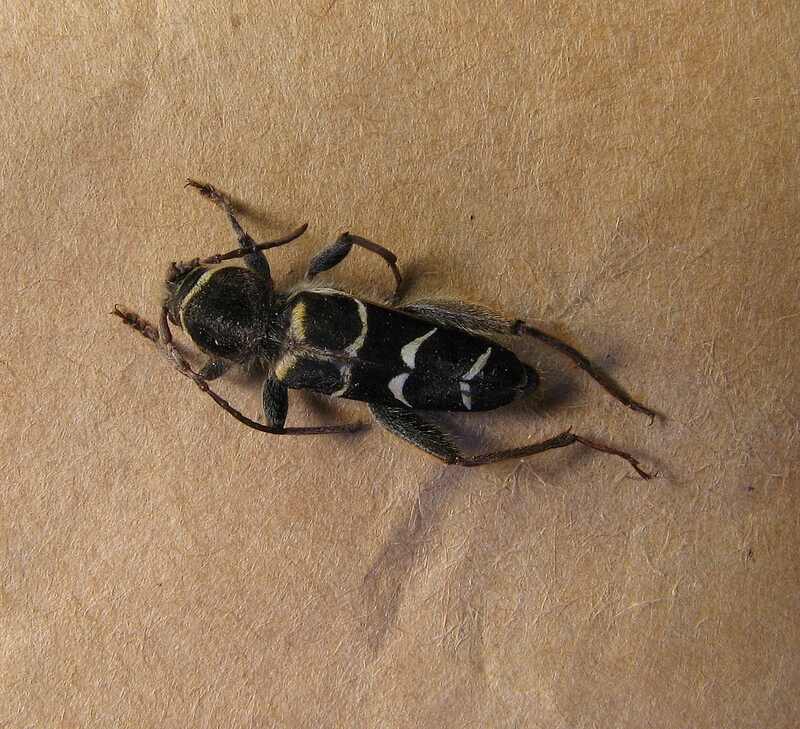
Trees affected: Ash, hickory, elm, mesquite, and white oak are the most common hosts of the banded ash borer.
Symptoms:
- Tunneling larvae of the banded ash borer may weaken a tree’s limbs, making them susceptible to breaking in strong winds.
- Infestation symptoms of the banded ash borer can be confused with the emerald ash borer. The banded ash borer’s tunnels tend to curve and zigzag with no direction, extending deep into the tree. The emerald ash borer, on the other hand, has S-shaped tunnels that are made directly under the bark of the tree.
- The exit holes of the banded ash borer are round, while the emerald ash borer produces D-shaped exit holes.
Causes: Unlike the emerald ash borer, the banded ash borer prefers to attack dead, dying, diseased, or stressed trees rather than healthy trees. In the spring, adults deposit eggs in the crevices of the host tree’s bark.
The larvae feed under the bark before boring into the sapwood, where they feed until the end of summer. In the fall, the larvae pupate and emerge as adults the following spring.
Treatment: Before infestation occurs, the Virginia Cooperative Extension recommends applying the systemic insecticides dinotefuran and imidacloprid as a soil drench. These insecticides may help kill the adult females chewing on the bark to lay their eggs and newly hatched larvae boring into the sapwood.
You may find adult banded ash borers in your home after emerging from firewood brought inside. Instead of treating the firewood with insecticides, leave the firewood outside your house until you want to burn it.
Risk: Because banded ash borers prefer dead or dying trees, your tree may already be at risk due to another disease or stress condition.
Ash Anthracnose Disease
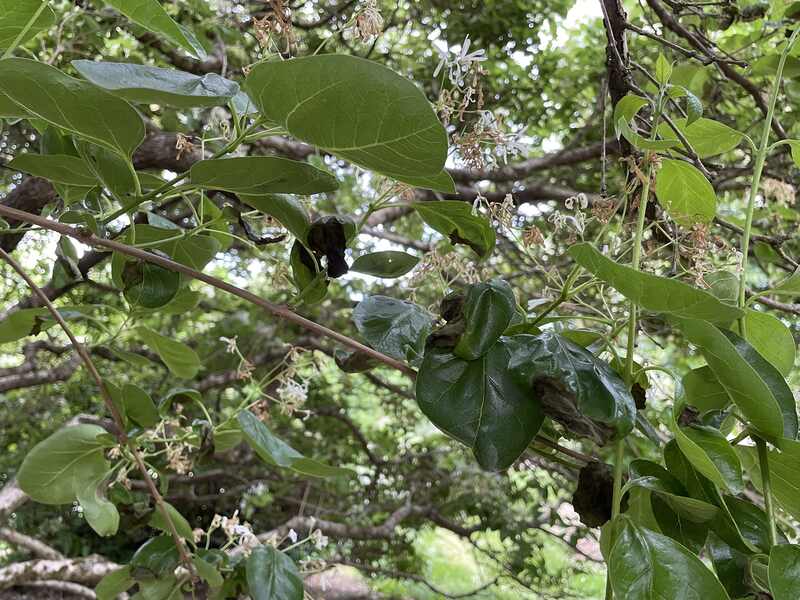
Trees affected: Ash anthracnose disease is especially common in green ash. Anthracnose is specific to the kind of tree it infects, so anthracnose of oak will not affect ash (Fraxinus spp.), and anthracnose of ash will not spread to any other type of tree besides ash. However, the symptoms and the management methods are the same for most anthracnose diseases of trees.
Symptoms:
- Leaves may develop large black or tan patches that cause the leaves to deform in those areas.
- Small purple-to-brown spots may also appear in the middle of the leaves.
- In severe cases, complete defoliation may occur.
- Symptoms typically first occur on the lower and inner canopy leaves.
Causes: The fungus that causes ash anthracnose, Gnomoniella fraxini, overwinters in the upper parts of trees in seed samara or on twig cankers. Spores form in tiny fruiting bodies and begin infection around the time the ash leaves are budding out. Spores are spread by wind and splashing rains to infect buds, twigs, and newly emerging leaves.
Season: Infection occurs in the spring and prefers wet, cool weather.
Treatment: Prune affected branches. In autumn, dispose of all fallen leaves to help prevent any excess spores from reinfecting in the spring. Iowa State University does not recommend the use of fungicides since anthracnose is rarely a severe problem in ash trees.
Risk: Ash anthracnose disease is rarely a concern for healthy mature trees unless it is severe for many consecutive years. If the tree experiences multiple reinfections, it may weaken and become vulnerable to other diseases and pests.
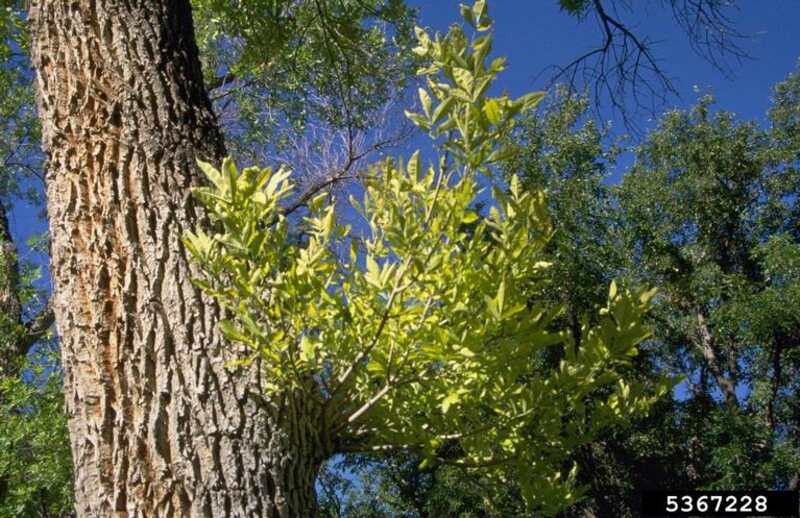
Trees affected: White ash is particularly susceptible to ash yellows, also known as ash decline. Ash yellows is also a common Arizona ash tree problem.
Symptoms: Ash yellows disease affects trees of all ages, and the following symptoms usually occur within three years of infection:
- Leaves may appear smaller, thinner, and lighter green.
- Trees will occasionally grow branches in tufts.
- Infected trees may grow at a much slower rate than non-infected trees, typically reaching about half the height of a healthy tree.
Causes: Ash decline is caused by the phytoplasma Candidatus Phytoplasma fraxinii, a bacteria-like organism. The phytoplasmas live and survive in the food-conducting tissue of the infected plant. There is no definitive cause of ash yellows, but leafhoppers may be the primary means by which the phytoplasmas spread from tree to tree.
Treatment: There is no known cure for this ash tree disease. Remove any infested trees immediately to prevent the spread of phytoplasma to healthy trees. According to the University of Wisconsin-Madison, wood from infected trees can be used as firewood or chipped for mulch.
Risk: Some infected trees may live and grow slowly with ash yellows for many years. Infected trees eventually experience branch dieback, gradually leading to tree death.
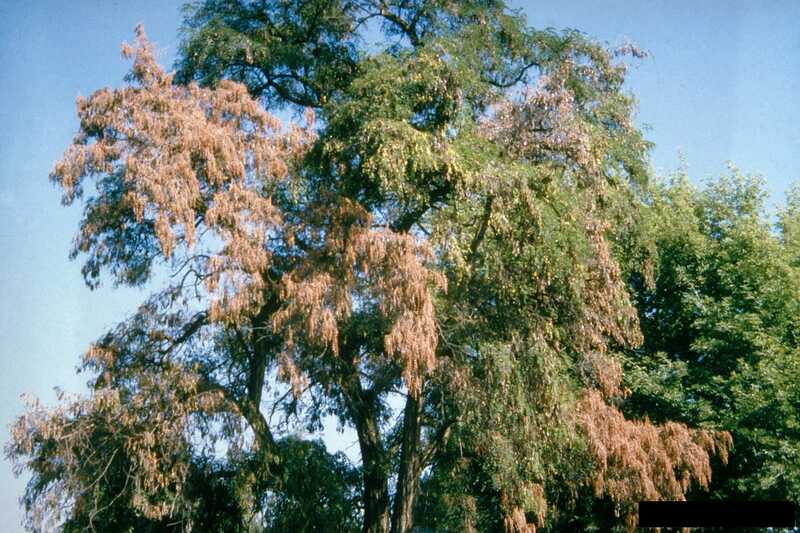
Trees affected: Verticillium wilt is a fungal disease that affects over 300 species of plants.
Symptoms:
- Leaf edges turn yellow, then brown and dry.
- Sudden wilting on one or several branches may occur. It’s often only one side of the tree that wilts.
- The wood underneath the bark of drooping branches often has discolored streaks. You may notice the wood’s discoloration after pruning.
Causes: Trees under stress from drought, nutrients, or salt are more likely to experience Verticillium wilt. The soil-borne fungus Verticillium albo-atrum causes Verticillium wilt.
Infection occurs in the root system, where the fungus produces resting structures that can survive in the soil for many years. The fungi that grow from these structures may penetrate the roots and cause water movement within the tree to suffer.
Season: Symptoms occur in midsummer.
Treatment: Since the fungus can live for a long time underground, it’s best to plant resistant trees in the contaminated soil. To delay the progression of Verticillium wilt, prune affected limbs and provide your tree with adequate water and fertilizer.
Risk: Verticillium wilt may kill your ash tree in a single season. Your ash tree may also survive for many seasons, with each branch slowly dying.
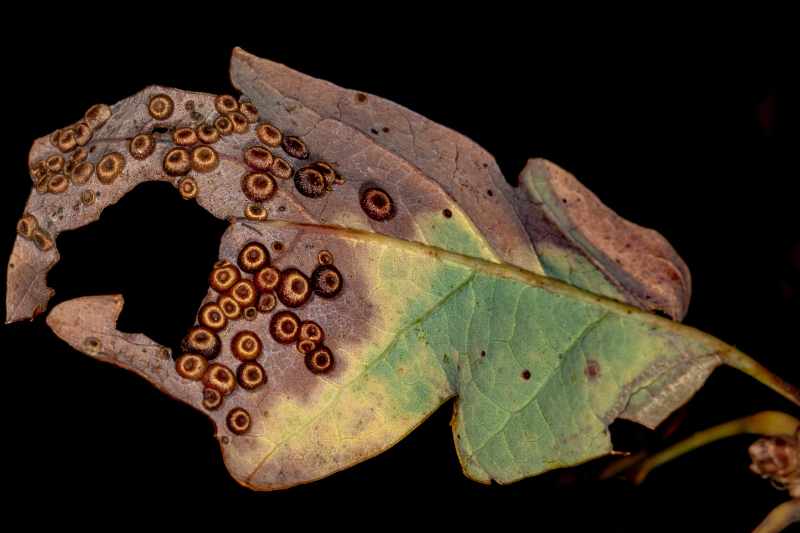
Trees affected: Susceptible ash trees include white, green, and black ash.
Symptoms:
- Small yellow or yellow-orange spots appear on the upper leaf surfaces.
- About 10 days later, bright orange-yellow clusters of spore-producing structures (aecia) develop underneath the leaf.
- Leaves may become distorted.
Twigs and stalks joining the leaf and stem (petioles) may develop wart-like swellings. These swellings will also form the clusters of aecia. Leaf tissue will begin to die, and some trees may appear scorched. Heavily infected trees may experience defoliation.
Cause: The ash rust fungus (Puccinia fraxinata) has five spore stages, two of which occur on an alternate host (marsh and cord grasses). In the spring, teliospores infect the tissues of ash, which then develop spermogonia and aecia. The aecia produce aeciospores, which the wind then blows to either alternate hosts.
Uredinia then form on the new hosts in early summer and produce urediniospores, which repeatedly infect cord and marsh grass. The uredinia will develop into brownish-black telia structures that produce teliospores. These teliospores then infect the ash trees the following spring.
Season: Symptoms may first appear in mid-May.
Treatment: The University of Delaware recommends applying Systhane WSP (myclobutanil) or Immunox. Fungicides may only act as a preventative measure and will not be an effective control method once your ash tree has been infected.
The Cooperative Extension suggests applying the fungicide two or three times around the time leaves start to expand. Then once or twice again at 10-day or two-week intervals.
Risk: Ash rust rarely kills trees.
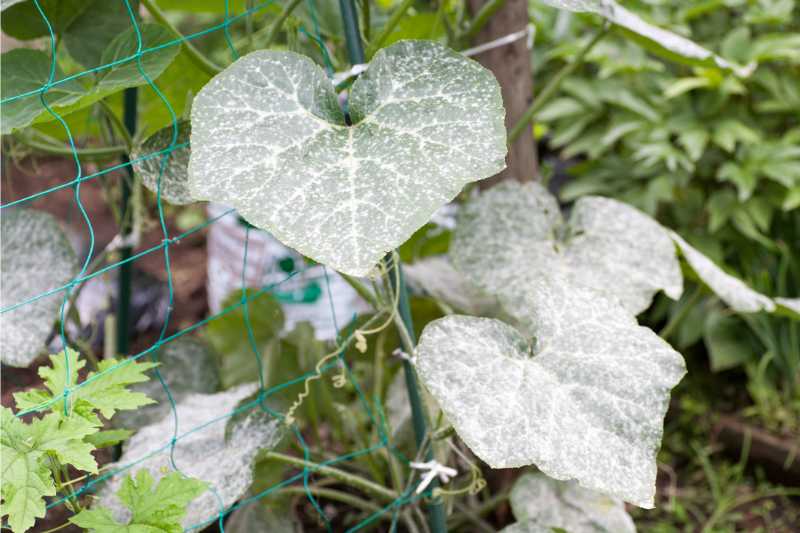
Trees affected: Powdery mildew can affect many trees. The most common include ash, lilac maple, dogwood, magnolia, basswood, crabapple, catalpa, and oak.
Symptoms:
- The fungi produce microscopic chains of spores that give the infected areas a white powdery appearance (upper and lower leaf surfaces, young stems, shoot tips, blossoms, and flower buds).
- The Infection may cause leaf yellowing, browning, distortion, or premature leaf drop.
Cause: A closely related group of fungi causes powdery mildew. The powdery mildew fungi overwinters inside infected buds. When the buds open in spring, they become covered with powdery spores, which the wind then carries to infect new leaves, fruit, and shoots.
Treatment: Plant susceptible trees in areas with adequate sunlight and good air circulation to reduce moisture. You may prune your plants to ensure air circulation. You can treat powdery mildew with a registered fungicide, which may also help to control the disease.
Risk: Powdery mildew is rarely lethal. Young ash trees growing in heavily shaded areas are the most affected by this disease.
Note: Powdery mildew can also affect your lawn. You can treat powdery mildew on your lawn with lawn fungicides and prevent the condition with cultural practices such as reseeding shady spots, watering properly, and mowing at the proper height.
How Late Can I Treat My Ash Tree?
FAQ
How to help a dying ash tree?
Can you revive an ash tree?
What does a dying ash tree look like?
What kills mountain ash trees?
